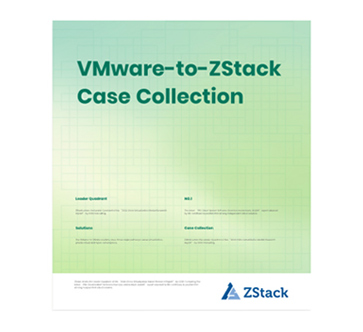ZStack Cloud Platform
Single Server, Free Trial for One Year
Comprehensive Data Center Infrastructure Solutions.
4S-compliant productized private cloud and seamless hybrid cloud
Offer a user experience consistent with VMware virtualization
A robust catalog of ready-to-deploy product
Supports storage resource pools with capacities exceeding PB levels
Covering scenarios from core to edge, cloud to cloud- native, and data management to AI
Deploy ZStack for scenario from datacenter to the edge.
ZStack provides innovative cloud infrastructure for ten major industries.
Comprehensive product documentation and tools
Upholding the value of Customer First and the mission of Serving Customer, ZStack is dedicated to providing secure and stable services for customers.
To educate ZStack partners and interested individuals about cloud computing and to cultivate cloud computing talent.
ZStack provides innovative cloud infrastructure for ten major industries

The report provides three major
solutions and customer case studies for transitioning from VMware to ZStack.
In order to strengthen the construction of new engineering disciplines and promote innovation in engineering education, Nanjing Tech University urgently needed to upgrade its existing IT infrastructure. The university’s various business systems were mainly running on physical machines and VMware environments, facing several challenges:
Given the current situation, Nanjing Tech Universityy urgently needed to build an advanced and comprehensive cloud platform to meet the needs of the university’s various business systems and create an integrated cloud service portal for the entire campus.
Nanjing Tech University upgraded its existing data center virtualization resources by adopting ZStack HCI, providing high-performance and highly available cloud hosts, cloud storage, and cloud network resource pools for critical information systems, including the logistics service monitoring system, human resources system, and student management system.
Using ZStack HCI’s virtualization management module, the university unified the management of its original VMware virtualization resources. Through V2V migration, the business workloads from VMware virtualization were migrated to ZStack HCI, enabling unified management of the original VMware resources. Additionally, ZStack HCI’s disaster recovery module provided various backup services for critical business systems.
Moreover, by introducing automated management technologies, the university was able to offer multi-tenant resource self-management and self-service capabilities, enabling dynamic allocation of cloud platform resources to various administrative departments, colleges, and departments. Each tenant could independently manage resources and perform tasks such as creating cloud hosts, improving the efficiency of campus business operations.

The case study collection covers three major alternative paths: virtualization, cloud platforms, and hyper-convergence. It includes over 600 typical customer practice experiences, spanning industries such as government, finance, education, transportation, manufacturing, and healthcare.

ZStack upholds the craftsmanship spirit, dedicated to refining products and co-evolving with customers in cloud-enabled IT. The company has now served over 4,000 clients.
 2025-02-05
2025-02-05
 2025-02-11
2025-02-11
 2024-12-12
2024-12-12
 2025-02-12
2025-02-12
 2025-02-13
2025-02-13
 2024-10-24
2024-10-24
 2025-03-13
2025-03-13
 2024-09-21
2024-09-21
 2024-10-10
2024-10-10
 2024-12-03
2024-12-03
